Skimming through some of the critical literature on the myth of Electra – who, following the murder of her father, the Mycenaean King Agamemnon, at the hands of her mother Clytemnestra and the latter’s lover Aegisthus, incites her returning brother Orestes to commit matricide and homicide – as told in varying forms by Sophocles, Euripides, Aeschylus, Voltaire and others, one notes how frequently the word ‘hatred’ is used to explain Elektra’s obsessive desire for vengeance. She is, we are told, ‘twisted by years of pure, unrelenting hatred’; a ‘damaged personality’ who has a ‘sense of her own degradation that results from years of suffering and hatred’. Such hatred has caused her to experience ‘a maiming – an inner disfigurement’, ‘harm to her soul’, ‘the ruin of her personality’. Some scholars do, however, point out that such views represent a Christian perspective on prolonged hatred, and the notion that it corrupts the mind of one who experiences it, and overlooks hat in 5th-century Athens openly avowed hatred for one’s enemy was regarded as natural and rewarding.[1]
For director Christof Loy, whose new production of Richard Strauss’s Elektra has just opened at Covent Garden, conducted by Sir Antonio Pappano, the opera is “not a piece about murder and bloody vengeance, but rather a piece about love, viewed from the dark side”. What drives the action, Loy argues, is “a yearning for love, and actually much more a yearning to be able to love someone than to be loved oneself”. And, if he does allow that Strauss’s and Hofmannsthal’s Elektra “fixates on her hatred. It is her thirst for vengeance that keeps her alive”, then he counters this with the view that “in her encounter with Orest you can tell how much she longs not to have to struggle any more, and to be protected and cared for the way she was when she was a child”.
Loy seems, then, to wish to eschew mythical monstrosities and bring the domestic side of the tragedy to the fore; to make the human experiences tangible. The libretto, though, does not encourage what we might feel are genuine ‘human’ interactions. Elektra’s opening monologue might perhaps be seen as an imagined dialogue with the dead father whose name she repeatedly invokes, but thereafter the characters tend to speak at each other not to each other. Even in the confrontation between Elektra and Klytämnestra, the Queen is unable to communicate with her daughter who responds in riddles and asides, until the dream sequence in which she brings Klytämnestra’s own nightmares into being, terrorising her mother with her visions of Orest’s murderous return. The ‘duets’ between Elektra and her sister Chrysothemis are essentially parallel monologues, as they speak of their opposing desires and Elektra curses Chrysothemis for her unwillingness to collaborate in her vengeful stratagem. Only in the recognition scene is there a real human connection between two individuals though this is largely communicated through the music.
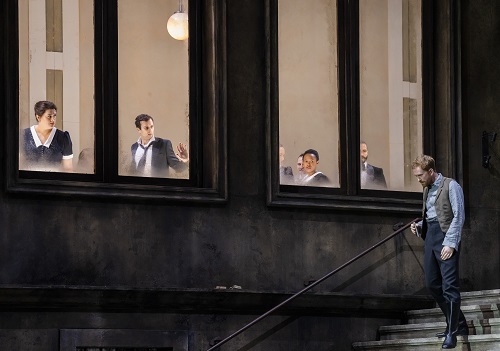
Loy’s austere staging and minimal direction does little to overcome the absence of humanity in Strauss’s opera. He frequently positions characters far apart, at opposite ends of the stage; they face the audience, turned away from each other, emphasising disconnection and interiority. Loy and designer Johannes Leiacker locate the action in Hofmannsthal’s turn-of-the-twentieth century Vienna, the royal palace of Mycenae transformed into one of the secession mansions on the Ringstraße boulevard. The single set presents a grubby courtyard at the rear of the palace, strewn with rubbish (a symbol of the fall of the house of Atreus, perhaps?), where the maids gather to smoke and deride Elektra and her rituals of devotion to her dead father. Stone steps lead up to an entrance to the house; towering picture windows facilitate a view of the revellers in modern-day evening dress dancing and preening under the glare of electric lights and enjoying the imperious Queen’s hospitality. Elektra’s subsequent brandishing of a flaming torch to guide Ägisth home to his death is thus a somewhat jarring anachronism. (And, one wonders whether lighting designer Olaf Winter might have done a little more to complement the shifting sonorities of Strauss’s score?)
Loy’s observation that “[t]he key to Hofmannsthal is always Vienna” suggests one way into his ‘reading’ of the opera, especially when he explains that the aim was “to create the atmosphere of Vienna around 1900, and to imagine things playing out behind the façades of the upper middle class, among the wealthy who keep up appearances no matter what”. These “appearances” distract people from thinking about “fundamental conflicts”, he adds. Might Loy be looking at the piece with a Freudian lens? After all, in 1903, the same year that Hofmannsthal wrote the play which attracted Strauss’s attention, the Viennese writer Hermann Bahr published Dialog vom Tragischen, in which, borrowing from and combining Nietzsche’s The Birth of Tragedy and Freud’s psychoanalytical theories, he proposed a new theory of Greek drama and tragic catharsis, reflecting some of the heady ideas that were circulating in contemporary Vienna. But, no: there’s no suggestion of a Freudian reading here – and certainly Elektra’s potentially incestuous feelings for her father and, in this context, rivalry with her mother have been the subject of critical debate – or of any other distinct ‘reading’. To say that Loy’s direction is light touch is an understatement.
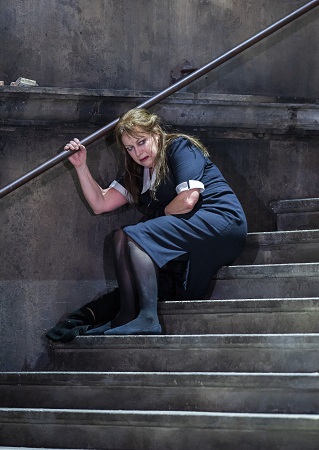
In any case, most of the audience were presumably at Covent Garden to hear the powerhouse trio of female singers in the central roles: the Swedish soprano Nina Stemme as Elektra, the Finnish mezzo-soprano Karita Mattila as Klytämnestra, and, making her debut in the House, the American soprano Sara Jakubiak as Chrysothemis. The applause was prolonged and rapturous at the curtain call, but not all was entirely well.
Nina Stemme’s commitment to the role was never in doubt. Her Elektra ran the gamut of emotions from dignity to despair, hatred to hysteria, stoicism to scorn. She glared, gloated, cowered and suffered, the physicality of her performance hypnotically intense, the gestures and expressions supremely detailed and engaging. Every moment of the long recognition scene with Orest (Łukasz Goliński) was imbued with emotive meaning conveyed by facial and physical gesture. Vocally, there was fragility in this scene, however, and despite her stamina and strength – Stemme rallied for her final frenzied monologue – on this occasion her dramatic soprano wasn’t quite sufficient for the huge demands that Strauss makes, the angularity and dissonance of his writing reflecting Elektra’s mental state, the sustained high-lying episodes expressing her obsessive single-mindedness and solipsism.
Some vocal roughness might indeed be apt at times, ugly thoughts warranting unbeautiful singing, and perhaps suggesting an inner vulnerability (though that would be more fitting if a younger singer were interpreting the role). But, while Stemme’s middle and lower voice were full and impactful, and she took great care with the softer, delicate moments, and with touching effect, at the top, where power, precision and focus are unremittingly required, the soprano was too often found wanting. The ending was strangely dissatisfying too. Deprived of her life spirit by the fulfilment of her desire for revenge, Elektra must die, but here her Totentanz, as she kicked off her black shoes and shuffled about with woeful lack of direction, was something of an embarrassment. No wonder the Old Servant (Jeremy White) looked the other way.
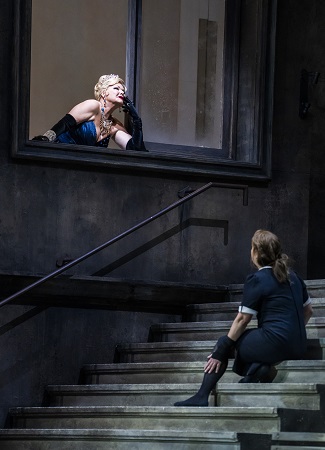
Karita Mattila’s diamanté-ed diva – done up to the nines in midnight-blue satin gown and white fur stole, dripping jewels and with sculpted coiffeur – was in danger of drifting into parody, at times verging on the histrionic, though she did still reveal the vulnerability, frustration and fear beneath the mask, and inspire a little sympathy. Mattila struggled to find the necessary opulence to project her lower register above the orchestral torrents, though, and the more conversational exchanges in the middle voice were occasionally unfocused.
In 1906, Strauss wrote to Hofmannsthal wondering if Elektra was not a little too similar to Salome, and whether he would have ‘the strength to handle a subject so similar to it in many respects with an entirely fresh mind’. Hofmannsthal batted away the suggestion that it might be better to ‘wait a few years’ until Strauss had ‘moved much farther away from the Salome style’: ‘The blend of colour in the two subjects strikes me as quite different in all essentials; in Salome much is so to speak purple and violet, the atmosphere is torrid; in Elektra, on the other hand, it is a mixture of night and light, or black and bright.’
That lightness and brightness is represented by Chrysothemis, who, regarded by Elektra as weak, embodies the opposing attitude towards the death of Agamemnon. This was a superb and vivid debut performance by Sara Jakubiak who sang throughout with glorious warmth and richness, soaring with radiant tone. The sisters’ final ‘duet’ is the culmination of the opera’s gradual movement towards a more lyrical expression and, as Elektra sank into self-absorbed isolation, Chrysothemis’s celebration of new life and new beginnings, of the essential goodness of the gods and the omnipotence of human love, provided a foil of ecstatic brightness.
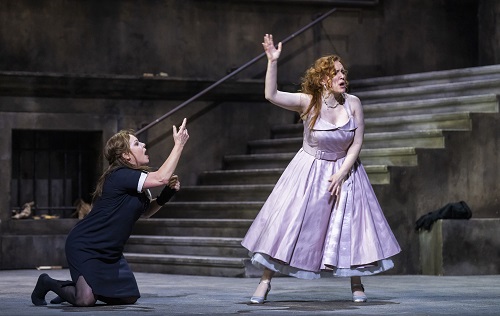
Hofmannsthal had originally conceived his 1903 Elektra as the first instalment of a two-part Orestiade, so it’s not surprising that Oreste did not feature largely since he would be the protagonist of the second, not-to-be-completed, part of the whole. Revisions made to the play in the formulating of the libretto made the recognition scene between the siblings the first main climax of the opera. But, Orest doesn’t have much music in which to establish his presence and command and the Polish baritone Łukasz Goliński didn’t make the most of the sparse opportunities. In his brief appearance as Ägisth, Charles Workman avoided caricature and played it straight.
The austerity of the static set and direction throw even more emphasis on the fact that the characters’ psychologies are communicated through the orchestral score. While Hofmannsthal’s play had been conceived as a psychological drama for a small theatre, Strauss’s opera was written for a large theatre, and he employed his largest orchestra – here spilling into the boxes at the side of stage. Pappano, conducting the last new production of his celebrated tenure as music director, drew customary excellence from the ROH Orchestra. He found detail and clarity amid Strauss’s sonorous density, shaping the leitmotivs with care and precision, allowing us to hear the delicate woodwind, to appreciate the imposing brass sequences and the interplay between orchestral groups. This wasn’t a reading of the score that swept up the listener in its chaotic embrace, but it was an intelligent and discerning one.
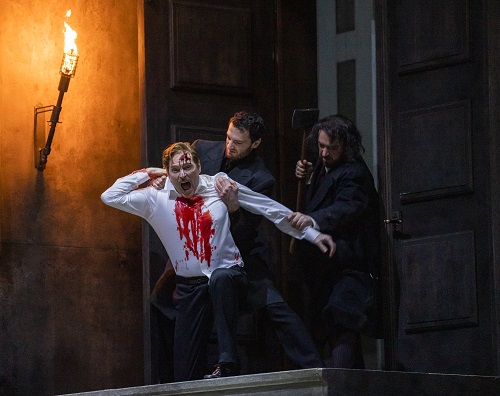
There is no chorus that might balance the orchestral extremes (or, rather, there is a short off-stage chorus about 90 minutes in, but it wasn’t audible to me on opening night), but there are a number of smaller roles. In the opening scene, the derisive maids were introduced with some individualisation, though their exchanges, and the countering voice (quickly stifled) expressing admiration for Elektra, did not establish a sense of seething tension as spite, fear and pity swirl. Michael Mofidian (Orest’s Companion) and Michael Gibson (Young Servant) sang competently.
Elektra is an opera of unrelenting accumulating tension, but the violence and mental anguish which pervade the work seemed here strangely at one remove. Perhaps Loy did not reconcile the two tragedies: the personal tragedy of Elektra, who as the director admits “is fairly unsympathetic in her intractability”, and the mythic, dynastic tragedy of the house of Agamemnon which, following Orest’s acts of matricide and murder will be sucked further into incessant cycles of violence. Despite his avowal that human qualities are uppermost in his vision, Loy offers little pathos. And, at the close, I did not feel catharsis.
Claire Seymour
First Maid – Noa Beinart, Second Maid – Veena Akama-Makia, Third Maid – Gabrielė Kupšytė, Fourth Maid – Ella Taylor, Fifth Maid – Valentina Puskás, Overseer – Lee Bisset, Elektra – Nina Stemme, Chrysothemis – Sara Jakubiak, Klytämnestra – Karita Mattila, Confidante – Marianne Cotterill, Trainbearer – Amanda Baldwin, Young Servant – Michael Gibson, Old Servant – Jeremy White, Orest – Łukasz Goliński, Orest’s Companion – Michael Mofidian, Ägisth – Charles Workman, Servants – Amy Catt, Tamsin Coombs, Andrea Hazell, Kiera Lyness, Deborah Peake-Jones, Cari Searl, Actors – Alexander Ballinger, Roseanna Bell, Kris Dillon, Ramin Farahani, Nathanael James, Simon Jaymes, Bu Kunene, Fabrizio Lloris, James Monckton, Eduardo Nunez, Yasset Roldan, Jonathan Savage, Saorla Wright; Director – Christof Loy, Conductor – Antonio Pappano, Designer – Johannes Leiacker, Lighting Designer – Olaf Winter, Chorus and Orchestra of the Royal Opera House (Chorus Director, William Spaulding)
Royal Opera House, Covent Garden, London; Friday 12th January 2024.
ABOVE: Nina Stemme (Elektra) in Elektra © ROH 2024. Photo by Tristram Kenton
[1] See for example, MacLeod, L. (2001) ‘Elektra and Orestes: Reunion and Vengeance’, in Dolos and Dikê in Sophokles’ Elektra. Leiden: Brill.